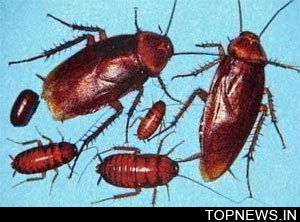Mites living on hissing cockroach may harbour allergy cure
 Washington, Apr 30 : A new research has revealed how tiny mites living on the surface of cockroaches may prove to be advantageous to humans with allergies.
Washington, Apr 30 : A new research has revealed how tiny mites living on the surface of cockroaches may prove to be advantageous to humans with allergies.
Mites, who thrive on the surface of Madagascar hissing cockroaches help decrease the presence of a variety of moulds on the cockroaches'' bodies, which in turn reduces allergic responses among humans who handle the popular insects.
For the study, the researchers cultured and identified fungi on the cockroaches'' body surfaces with and without mites and discovered that the presence of these mites reduced the moulds by at least 50 percent.
"We haven''t proved yet that this helps the cockroaches, but reducing the fungi present on their surface is beneficial overall. By suppressing the molds, the mites have a role in reducing allergic reactions to cockroaches," said Joshua Benoit, a doctoral student in entomology at Ohio State University and a co-author of the study.
In a previous study on the Madagascar hissing cockroach, or Gromphadorhina portentosa, researchers discovered the moulds on cockroach surfaces.
But, as it turns out, not all colonies of Madagascar hissing cockroaches harbour the mites, a species called Gromphadorholaelaps schaeferi.
Although the researchers are unaware of the reason behind such preference, they found that the cockroaches that do harbour mites also harbour fewer moulds on their bodies.
In the study, female cockroaches with mites had 64 percent fewer fungal colonies than those lacking mites. In males, the difference was 31 percent, and in nymphs, or younger and smaller cockroaches, there were 24 percent fewer fungi.
For conforming if mites were responsible for the reduction in fungi, the researchers tested colonies with and without mites, but also removed mites from colonies that originally had mites and added mites to cockroaches that didn''t initially harbour any mites.
In all cases, the presence of mites resulted in lower levels of mould.
"The presence of the mites caused a reduction in all fungi on the surface, not just a select few kinds of fungus," said Jay Yoder, a professor of biology at Wittenberg University and lead author of the study.
While almost 20 to 25 mites live on each adult cockroach, the scientists experimented by adding more mites to the insects'' surfaces, but found that more mites didn''t result in a more significant reduction in molds.
"The number on each insect is based on the food available," said Benoit.
As of now, the researchers have described the symbiotic relationship as commensalism rather than mutualism, which means that just one species clearly benefits and no damage is done to the other.
The research is published in the current issue of the journal Symbiosis. (ANI)